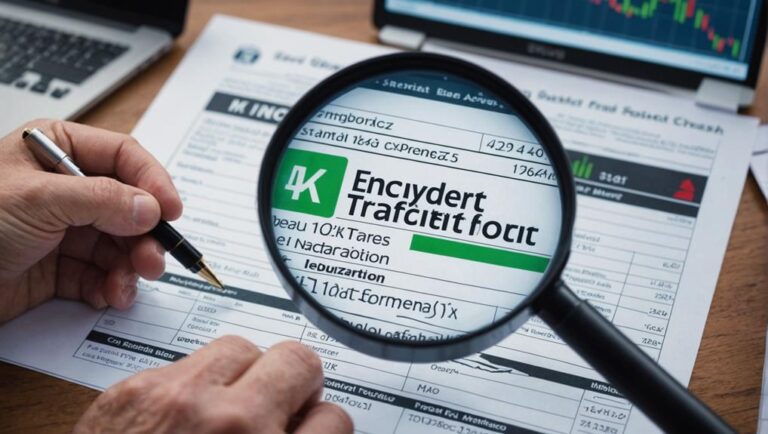Overview of SEC Form 4 and Its Importance in Disclosing Insider Trading

SEC Form 4 plays a crucial role in upholding market integrity by ensuring transparency in insider trading activities. It mandates that company directors and officers must promptly disclose any transactions involving company securities within two business days. This disclosure includes essential information such as the transaction dates, types of securities involved, and the quantity of shares traded, contributing to a more open and honest financial environment. Investors rely on Form 4 filings to assess insider sentiment and make well-informed decisions based on the disclosed information.
Failing to submit SEC Form 4 in a timely manner can result in penalties for the individuals involved. This requirement acts as a deterrent against illegal practices and promotes fairness in trading by holding insiders accountable for their transactions. By mandating timely and accurate disclosures, Form 4 helps prevent potential insider trading abuses and ensures that all market participants have access to relevant information for making investment decisions.
In essence, SEC Form 4 is a critical tool for promoting transparency and integrity in the financial markets. It serves as a means of monitoring insider trading activities, allowing investors to have a clearer picture of the actions of company insiders. By requiring timely disclosures of changes in ownership of company stock by insiders, Form 4 helps maintain a level playing field for all market participants and fosters trust in the overall market system.
Key Takeaways
SEC Form 4 serves as a crucial tool in monitoring insider trading activities within publicly traded companies. This form mandates that company directors and officers must disclose any transactions involving their company's stock within two business days. By requiring prompt disclosure, Form 4 promotes transparency in the market and acts as a deterrent against illegal insider trading practices.
Investors rely on the information provided in Form 4 filings to assess insider sentiment and make well-informed investment decisions. These disclosures include essential details such as transaction dates, types of securities traded, and ownership changes, ensuring a comprehensive overview of insider trading activities within a company.
It is imperative for insiders to adhere to the timely filing requirements of Form 4 to avoid potential penalties and enforcement actions. Failure to comply with the disclosure rules set forth by the SEC can lead to legal repercussions for individuals engaging in insider trading practices. Therefore, the accurate and timely submission of Form 4 filings is essential for upholding market integrity and protecting investors' interests.
Definition of SEC Form 4
SEC Form 4, also known as the Statement of Changes in Beneficial Ownership, is a document insiders such as company directors and officers must submit to the SEC. This form is crucial for monitoring insider trading activities. When insiders, who hold significant sway within the company, buy or sell company securities, they're required to promptly disclose these transactions on Form 4. This practice ensures transparency and keeps the public well-informed.
The Form 4 contains specific details, including the reporting person's identity, the company's name, the transaction date, the type of security involved, the quantity of shares bought or sold, and the transaction price. These particulars offer a comprehensive overview of the insider's trading actions, which is valuable information for both investors and regulatory bodies.
It is essential for insiders to file Form 4 without delay. They must submit the form within two business days of the transaction taking place. Non-compliance with this requirement can result in serious consequences, such as civil or criminal penalties.
Importance of SEC Form 4
Understanding the importance of SEC Form 4 filings is crucial for transparency and trust in financial markets. When discussing securities and insider trading, timely disclosure through Form 4 is essential. It unveils alterations in beneficial ownership within publicly traded companies, ensuring market integrity and enabling investors to make well-informed decisions.
Form 4 serves a pivotal role in various ways. Firstly, it helps in deterring illegal insider trading by necessitating prompt reporting of insider transactions, thereby maintaining a level playing field for all market participants.
Secondly, it promotes market integrity by fostering transparency in significant transactions by company insiders, which is vital for the overall health of financial markets.
Lastly, investors and analysts rely on Form 4 filings to evaluate insiders' sentiment towards their company's future performance, offering valuable insights for potential investment strategies.
As we navigate the complexities of securities markets, the accuracy and timeliness of Form 4 disclosures are paramount. They act as a safeguard against misconduct, uphold market integrity, and equip us with the knowledge necessary to make strategic investment decisions.
Who Must File Form 4

Corporate insiders, such as directors, officers, and shareholders with over 10% ownership of a company's stock, are mandated to submit Form 4 to disclose their transactions. This SEC form plays a crucial role in upholding transparency and credibility in the financial markets.
Whenever these insiders conduct transactions involving company securities, be it purchases, sales, or options, they must promptly report these activities. This reporting requirement ensures that changes in ownership are publicly disclosed, promoting a level playing field for all investors.
In the dynamic realm of finance, the timely filing of Form 4 isn't merely a procedural obligation but a cornerstone in preventing illicit practices like insider trading and instilling trust among investors. Failure to comply with the disclosure requirements can lead to severe repercussions, including enforcement actions by the SEC, whether civil or criminal in nature.
Accessible through the SEC's EDGAR system, Form 4 filings enable investors and analysts to monitor insider transactions closely. These filings unveil valuable insights and trends regarding the company's internal dynamics, empowering stakeholders to make well-informed investment choices.
Timing of Form 4 Filings
Understanding the significance of adhering to the SEC's filing deadline requirements for Form 4 is crucial.
These forms need to be submitted promptly, within two business days of the insider transaction taking place.
This ensures that all reported information on transaction dates is both timely and accurate.
Failing to meet this deadline can result in severe compliance issues and penalties, underscoring the critical importance of timely submissions.
Filing Deadline Requirements
Meeting the two-business-day deadline for Form 4 filings is crucial to ensure prompt disclosure of insider transactions. This requirement, mandated by SEC regulations, plays a vital role in transparently communicating insider trades to the public and maintaining market integrity. Compliance with these filing deadlines isn't merely a regulatory obligation but a fundamental element in preventing delayed or undisclosed insider transactions.
To effectively adhere to the SEC's disclosure requirements, it's essential to focus on three key aspects:
- Awareness: Understanding the specific timing and types of transactions that necessitate a Form 4 filing is essential to prevent any unintended delays.
- Preparation: Establishing a reliable internal system to efficiently track and report insider transactions is crucial. This includes having dedicated personnel or automated systems in place.
- Accountability: Holding responsible individuals accountable for meeting filing deadlines is paramount to avoid potential civil or criminal actions for non-compliance.
These strategies help ensure timely and accurate disclosure of insider transactions, fostering transparency and trust in the market.
Reporting Transaction Dates
Understanding the exact timing for reporting transaction dates is crucial to meet the two-business-day filing requirement for Form 4. When insiders conduct transactions, they must promptly report the date of the transaction. This ensures that any significant changes in their holdings are disclosed without delay.
Filing deadlines aren't just administrative tasks; they play a critical role in upholding transparency in insider trading activities. Adhering to these filing deadlines is of utmost importance.
The two-business-day window for submitting Form 4 is specifically designed to provide timely information to the market, enabling all stakeholders to respond appropriately. Failure to meet this deadline can result in severe legal consequences, such as fines and penalties.
Such delays not only impact the integrity of market operations but also diminish trust among investors.
Compliance and Penalties
Timely Form 4 filings are crucial for maintaining compliance with SEC regulations and upholding market integrity. Adhering to the two-business-day filing deadline ensures that insider transactions are transparent and accessible to the public. This transparency plays a key role in preventing illegal insider trading practices and building trust in the financial markets.
Failing to meet the filing deadline can lead to significant consequences, such as facing civil or criminal actions from regulatory authorities. The SEC diligently monitors these filings to identify any potential violations and enforce regulatory compliance. By meeting the deadlines, we actively contribute to creating a more transparent and equitable market environment.
Three essential reasons to comply with Form 4 filing deadlines are:
- Transparency: Prompt filings offer real-time insights into insider trading activities, fostering a level playing field for all market participants.
- SEC Oversight: The SEC relies on these filings to monitor and investigate any suspicious activities, ensuring that trading regulations are upheld.
- Avoiding Penalties: Consistent compliance helps individuals avoid severe penalties, such as civil or criminal actions, which can damage reputations and lead to financial repercussions.
Information Required in Form 4

When filling out Form 4, it's essential to provide detailed information on transaction dates and the type of ownership being affected. This requirement ensures that every insider transaction, whether it involves a purchase, sale, or stock option exercise, is clearly documented.
Transaction Date Details
Ensuring the precise reporting of the transaction date on Form 4 is vital for upholding transparency in insider trading activities. Insiders are obligated to disclose the date of their securities transactions accurately. This transparency enables investors and regulators to monitor the timing of these trades, offering a clear view of the insider's actions in relation to significant company events.
Form 4 underscores the critical nature of accuracy in the transaction date for multiple reasons:
- Regulatory Oversight: Regulators scrutinize transaction dates to confirm adherence to insider trading regulations and identify any potentially illicit behavior.
- Investor Perception: Investors utilize timing details to assess insider confidence and make well-informed decisions based on the perceived significance insiders attribute to the company.
- Event Correlation: Precise transaction dates facilitate the evaluation of trades in conjunction with major company announcements or market fluctuations.
Ownership Type Disclosure
Disclosing ownership type in Form 4 is crucial for investors to understand the insider's relationship with the company. This transparency allows investors to make well-informed decisions when considering their investments. Form 4 provides a clear view of how insiders, such as executives and directors, hold their shares, helping investors gauge their level of influence within the company.
Form 4 mandates the disclosure of three primary types of ownership: beneficial ownership, direct ownership, and indirect ownership. Beneficial ownership includes shares held by family members or entities controlled by the insider, providing a comprehensive understanding of the insider's true impact.
Direct ownership pertains to shares personally owned by the insider, offering a direct insight into their financial stake in the company. Indirect ownership is more intricate, encompassing securities held through trusts, partnerships, or other entities controlled by the insider.
Differences Between Form 3, 4, and 5
Understanding the disparities between Form 3, Form 4, and Form 5 is crucial in comprehending insider trading activities and ownership alterations within a corporation. Each form plays a unique role and has a specific timeline, ensuring a comprehensive public disclosure of insider actions.
Form 3 is the initial declaration made by new insiders within 10 days of acquiring ownership in a company. It serves as their first disclosure of ownership of the company's securities, establishing a baseline for future transactions.
Form 4 is promptly filed within two business days after an insider carries out a transaction, revealing their activities in company securities. This rapid filing requirement guarantees timely updates on insider trading actions, utilizing transaction codes to specify the nature and details of each transaction.
Form 5 is submitted no later than 45 days after the company's fiscal year concludes. It captures transactions that weren't previously reported during the year, ensuring that no insider trading activity goes unnoticed.
How to File Form 4

To file Form 4, insiders must utilize the SEC's EDGAR system and complete the process within a strict two-business-day deadline. Accessing the SEC's EDGAR system is crucial as it's a powerful electronic gateway specifically designed for mandatory disclosure of insider transactions involving company securities.
Once logged in, insiders can locate a downloadable version of Form 4 on the SEC website, which provides guidance on capturing essential details such as purchases, sales, and stock option exercises.
Electronic filing isn't only efficient but also essential for complying with the SEC's requirements, ensuring transparency and adherence to regulations. Insiders in publicly traded companies are obligated to meticulously document each transaction, providing accurate data to uphold market integrity.
The user-friendly nature of the EDGAR system allows for swift uploading of the completed Form 4, facilitating the disclosure process.
While exceptions to electronic filing may be granted in rare cases of hardship, approval is required. By following the SEC's guidelines and effectively utilizing the EDGAR system, insiders uphold the principles of transparency and trust that are fundamental in financial markets.
Timely and diligent filing of Form 4 plays a crucial role in fostering an innovative and fair trading environment, benefiting all market participants.
Analyzing Form 4 Data
Analyzing Form 4 data reveals trading patterns that may indicate insider confidence or concern regarding the company's future. This analysis helps us understand not only individual transactions but also broader regulatory implications.
Scrutinizing these filings carefully provides valuable insights into potential market movements and company performance.
Insider trading activity, as disclosed in SEC Form 4 filings, can offer a glimpse into the sentiment of company insiders. By examining these transactions, we can assess the level of confidence or caution among key individuals within the organization. This information is crucial for investors and analysts seeking to make informed decisions about their investments.
Form 4 filings are a regulatory requirement meant to ensure transparency and accountability in the financial markets. Monitoring these disclosures can help detect any irregularities or potential misconduct, thereby contributing to a more efficient and trustworthy market environment.
It's essential to stay vigilant and analyze Form 4 data regularly to stay informed about insider trading activities and their implications for stock performance.
Identifying Trading Patterns
Studying Form 4 data offers a glimpse into insider trading behaviors that can serve as indicators of shifts in company sentiment. By carefully analyzing these filings, we can determine whether insiders are consistently buying or selling shares, providing valuable insights into their confidence or apprehensions regarding the company's future. This detailed examination of trading patterns can uncover actionable information.
Keeping track of the frequency and volume of insider trades can offer valuable insights into their perception of the company's direction. Regular transactions may indicate strong insider confidence or significant concerns about the company's performance.
Monitoring changes in insider trading behavior over time using Form 4 data can help in forecasting potential stock movements. For example, a sudden surge in buying activity could be a sign of anticipated positive developments.
Conducting a comparative analysis of Form 4 data among different insiders enables us to identify contrasting views on the company's outlook. Varied actions, such as top executives selling shares while others are buying, may suggest internal disagreements about the company's strategic direction.
Form 4 filings provide a wealth of information on insider sentiment. By examining these trading patterns, we can gain a deeper understanding of the factors influencing insider confidence and make more informed investment decisions.
Regulatory Implications Analysis
Analyzing Form 4 data allows us to uncover potential insider trading activities that could harm market integrity. This analysis is essential for detecting patterns, trends, and anomalies in insider trading behavior.
When we review SEC filings, our goal is to ensure that these transactions adhere to securities laws and don't undermine investor confidence.
In our efforts to uphold market integrity, understanding the intricacies of Form 4 helps us identify instances where insiders may be using non-public information for personal profit. It's not just about catching those who are in the wrong; it's about maintaining a fair environment where all investors can have faith in the system.
Regulators heavily rely on this analysis to identify potential breaches of securities laws. By examining the data closely, we can offer insights that help prevent unfair advantages and promote transparency.
This process isn't just about ticking boxes for regulatory purposes; it's crucial for the well-being of our financial markets.
When we conduct regulatory implications analysis, we aren't only safeguarding the market in the present but also ensuring its strength and fairness for future generations.
Form 4 filings are more than just bureaucratic tasks; they're fundamental pillars of a transparent and equitable financial ecosystem.
Case Study: Form 4 Filing

Gregory Becker filed his Form 4 on February 27, detailing a $3.6 million stock sale and the exercise of stock options. As the CEO of Silicon Valley Bank, Becker's actions offer insight into insider trading activities governed by SEC regulations.
The Form 4 disclosed key information, including the exercise of 12,451 options at $105 each before selling the resulting shares. Initially, Becker held 92,552 shares of Silicon Valley Bank securities, making this transaction significant.
To understand Becker's insider trading activity, it's important to consider his use of the Rule 10b5-1 trading plan. This SEC provision enables insiders to establish a prearranged plan for stock sales, reducing the risk of insider trading allegations. Becker's adherence to this rule indicates a strategic approach to the sale.
From Becker's filing, we learn the following:
- Transaction Specifics: The Form 4 offers detailed information on transaction dates, types of securities, shares, and prices.
- Insider Strategy: The Rule 10b5-1 plan illustrates how insiders can navigate stock sales within legal boundaries.
- Compliance Importance: Becker's filing emphasizes the significance of complying with SEC regulations for transparency.
Impact on Investors
Understanding Gregory Becker's Form 4 filing provides valuable insights into how insider trading disclosures impact investors. Analyzing insider transactions like Becker's allows us to gauge corporate insiders' confidence in their companies. When insiders buy or sell shares, it often reflects their outlook on the company's future performance, offering critical information for investors making decisions.
Tracking Form 4 filings helps us spot patterns in insider trading, giving us a unique perspective on potential shifts in a company's strategic direction. Significant transactions can act as early signals of changes, prompting us to review our investment strategies.
For instance, a spike in insider buying may indicate forthcoming positive developments, while extensive selling could raise concerns.
Furthermore, Form 4 disclosures enhance transparency and accountability in financial markets. These filings ensure that investors stay informed about insider activities, promoting fair play. By aligning insiders' actions with their public statements, we can better assess a company's prospects and make more confident choices.
In a market driven by innovation and foresight, Form 4 stands as a vital tool for savvy investors.
Regulatory Framework and Compliance

The regulations governing Form 4 filings ensure that insiders promptly disclose their securities transactions, promoting market transparency and investor trust. The Securities Exchange Act of 1934 mandates that insiders, such as directors, officers, and shareholders owning over 10% of a company, must file Form 4 to report changes in beneficial ownership. This framework ensures that all relevant parties comply with insider trading laws.
Insiders are required to identify and accurately report any material changes in their ownership. The Form 4 must be submitted within two business days of the transaction, a critical timeframe for maintaining real-time market integrity. Accuracy in Form 4 filings is essential to avoid legal repercussions.
Non-compliance with Form 4 filing requirements can result in severe consequences, including civil or criminal actions by the SEC. Adhering to this regulatory framework upholds the principles of fair and transparent trading, fostering an environment conducive to innovation and trust in the market.
Frequently Asked Questions
What Is the Purpose of SEC Form 4?
We use SEC Form 4 to ensure regulatory compliance by insiders, detailing their transaction types within the specified reporting timeline. By meeting filing deadlines, insiders disclose changes in beneficial ownership, fulfilling the requirements of Form 4 and upholding transparency in their transactions. Insiders are required to report any changes in their ownership of company stock promptly to the Securities and Exchange Commission (SEC) through Form 4. This disclosure helps investors and the public understand the trading activities of insiders, which can impact the company's stock price and overall market perception. Form 4 plays a crucial role in maintaining the integrity and transparency of the financial markets, ensuring that insider trading activities are properly monitored and disclosed.
For What Purpose Is the Sec's Registration Form S 4 Used?
While SEC Form 4 focuses on disclosing changes in ownership of company stock by insiders, SEC Form S-4 is primarily used to provide detailed information related to mergers. This form includes a proxy statement, information on stock issuance, registration rights, business combinations, and equity compensation. By offering transparency and comprehensive details on these aspects, Form S-4 plays a crucial role in aiding investor decisions when companies are involved in mergers or acquisitions.
What Does Form 4 Tell You?
SEC Form 4 discloses insider transactions, providing detailed information on directors' dealings, insider purchases, and equity holdings. These transactions are crucial for investors as they reveal important insights into company sentiment and potential market movements. By specifying transaction dates and fulfilling reporting obligations, Form 4 enables investors to make informed decisions based on the actions of company insiders.
Insider transactions, as reported in Form 4, can signal confidence or concern among company insiders regarding the future performance of the company. For example, a significant insider purchase may indicate a positive outlook on the company's prospects, while a large sale could suggest potential issues. Monitoring Form 4 filings can help investors stay informed about insider activities and possibly anticipate stock price movements.
What Is the SEC Disclosure for Insider Trading?
Did you know that 85% of market volatility is attributed to insider trading? The SEC's disclosure rules require prompt reporting of changes in ownership of company stock by insiders. This is known as SEC Form 4, which is designed to enhance trading transparency and uphold corporate governance. By ensuring that insiders comply with these strict regulations, the SEC aims to protect market integrity.
Insider trading can have a significant impact on market stability and investor confidence. By requiring insiders to report their transactions promptly through Form 4, the SEC helps to prevent unfair advantages in the market and promote a level playing field for all investors. This transparency is essential for maintaining trust in the financial markets and ensuring that companies operate ethically and responsibly.
Conclusion
We've delved into the intricacies of SEC Form 4, emphasizing its crucial role in unveiling insider trading activities. It's quite intriguing, isn't it, how a seemingly mundane document holds such immense power in ensuring market transparency?
By carefully monitoring and dissecting these filings, we, as investors, can make more informed choices. In essence, while Form 4 may seem like just another regulatory requirement, it stands as a vital instrument in upholding market integrity and safeguarding the interests of investors.






